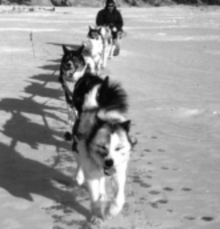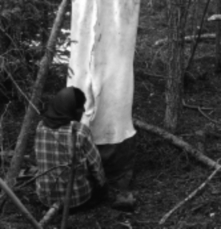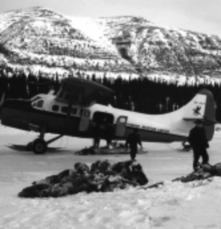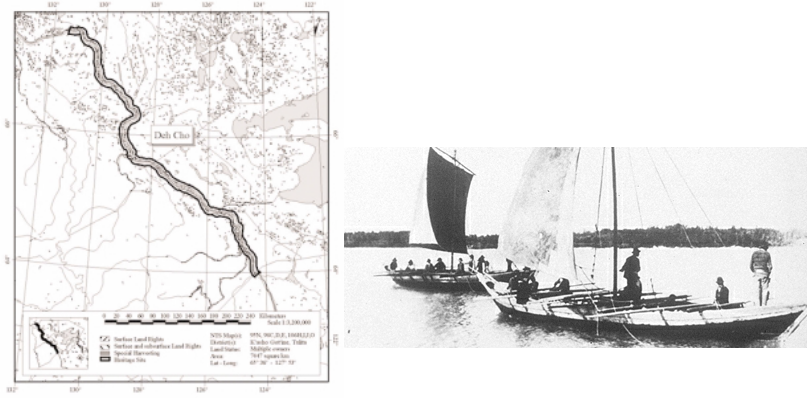The Sahtu in the 20th Century
The discovery of oil at Norman Wells in 1919 unleashed a new dynamic in the region. The signing of Treaty 11 a year later provided the legal basis for developing the oil wells. A rapid influx of southerners increased the exposure of Dene people to deadly epidemics. In 1928, a devastating flu epidemic took the lives of about 600 people in the Mackenzie District of the Northwest Territories, about 10-15% of each village. Tuberculosis and pneumonia spread in the wake of the epidemic, preying upon the weakened survivors. Between 1937 and 1941, tuberculosis was found in the District at a rate fourteen times the national average, and pneumonia at a rate of more than double the average. One Edmonton doctor visiting the NWT noted in 1934 that he could not find “a single physically sound individual” (quoted in Abel 1993, 208).



Top - Hunters travelling by dog sled
Middle - Madeline Karkagie (Tulita) smoking hide.
Bottom - Caribou meat ready for transport
photos © Norm Simmons
Bishop Gabriel Breynat was a tireless advocate for the sick and destitute Dene peoples. In 1938, he wrote an article entitled “Canada’s Blackest Blot” that was published in the Toronto Star Weekly, in which he noted that in “carefully compiled figures for 12 months during 1935-1936 (an exceptionally good year), it is estimated that the per capita income of these Indians was $110” (quoted in Fumoleau 1996, 300).
Increasingly restrictive fur and game harvesting laws were an additional blow to Dene peoples, who already felt betrayed by broken promises in the aftermath of Treaty 11. In 1928, closed seasons on beavers were imposed, and further restrictions were added in amendments to the Game Act in 1929. This was despite evidence that non-aboriginal trappers from the south were having the greatest impact on wildlife populations.
Fortunately, the game laws probably did not have much impact on the communities of the Sahtu. Many people were not aware of the laws, and local agents and police likely recognised the futility of attempting to enforce them (Abel 1993). However, by the end of the 1930’s, the Depression was affecting the Mackenzie Valley as fur prices crashed. An era that lasted 140 years in the Sahtu was coming to a close.
Meanwhile, the discovery of pitchblende at Port Radium on Great Bear Lake and gold at Yellowknife marked a turning point in the economy of the Mackenzie District in the 1930s. The opening of the Sǫmba K’e (Port Radium) mine on Great Bear Lake in 1933 created a new home market for oil. Production of petroleum at Norman Wells increased at a dizzying speed, especially with the additional demand created in 1937 by the opening of gold mines in Yellowknife. Imperial Oil built a new refinery, and drilled two new wells. Production went from 910 barrels per year in 1932 to over 22,000 in 1938. In 1946, mineral production exceeded fur production in value, for the first time in the north.
Today, the economy of the Sahtu Region is based on a mix of industrial resource extraction, tourism, traditional trapping and subsistence harvesting. People of the Sahtu continue to rely on the land as a source of income, food, security and identity. Many Dene and Metis people have found ways to combine wage employment in town with traditional activities in the bush. Although young people are learning modern skills in school, there is also a movement to ensure that they are provided with teaching by their elders in the skills and knowledge needed for survival on the land.
Deh Cho (Mackenzie River)
The Deh Cho or 'Big River', from Blackwater River in the south, to Thunder River in the north, was and remains a very important route for Sahtu Dene and Metis... As a traditional use area, the Deh Cho continues to provide domestic fisheries, moose and waterfowl hunting areas, travel access to many other locations. It is associated with numerous legends, including stories of Yamoria.

[ Sahtu Atlas Table of Contents ]
[ Next Section ]



 Phone: 867-374-4040
Phone: 867-374-4040 Email:
Email: